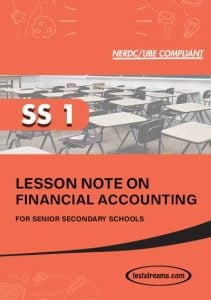This Financial Accounting Lesson Note was pulled from our book (Lesson Note on FINANCIAL ACCOUNTING for SS1 MS-WORD);Compiled to serve as a reference material to help teachers draw out their lesson plan easier, saving you valuable time to focus on the core job of teaching.
The Lesson notes are based on the current NERDC curriculum (UBE compliant)
This Finacial Accounting Lesson Notes CoversThe Following Topics
- PREPARATION OF COMPANY INCOME
- APPROPRIATION ACCOUNT OF A COMPANY
- COMPANY BALANCE SHEET
- CAPITAL MARKET: MEANING; REASONS FOR REGULATION; TYPES OF REGULATION
- SECURITY AND EXCHANGE COMMISSION
- NIGERIA STOCK EXCHANGE
- HIRE PURCHASE/INSTALMENTAL PAYMENT ACCOUNT
- CONSIGNMENT ACCOUNT
- JOINT VENTURE
- REVISION
- CONTRACT ACCOUNT: SECOND TERM SS3 ACCOUNTING
- ACCOUNTING RATIO: SECOND TERM SS3 ACCOUNTING
- DEPARTMENTAL ACCOUNT: SECOND TERM SS3 ACCOUNT
- BRANCH ACCOUNT: SECOND TERM SS3 ACCOUNTING
- PUBLIC SECTOR ACCOUNTING: SECOND TERM SS3 ACCOUNTING
- PERSONNEL COST BUDGET: SECOND TERM SS3 ACCOUNTING
- PREPARATION OF FINAL ACCOUNTS WITH END OF YEAR ADJUSTMENT
What is Income Statement?
A company’s income statement is a financial statement which documents and reports on such a company’s financial performance over a specific accounting period. Said financial performance is assessed by giving a summary of how the business incurs its revenues and expenses through both operating and non-operating activities. It also shows the net profit or loss incurred over a specific accounting period. Known also as the profit and loss statement or statement of revenue and expense, the income statement is one of three major financial statements in every company’s annual report. In other words, every public company must submit these legal documents to the Securities and Exchange Commission (SEC) and hence the investor public.
Please note that unlike the balance sheet, which covers one moment in time, the income statement provides performance information about a time period. It begins with sales and works down to net income and earnings per share.
How to Prepare a Company’s Income Statement
To prepare an income statement, it is important to begin by calculating Net Sales and Cost of Goods Sold using the information that appears on the worksheet. Afterwards, use the rest of the numbers from the worksheet to prepare the income statement.
Finding Net Sales: Net Sales is a total of all the sales minus discounts. In order to calculate Net Sales, first look at the line items regarding sales, discounts, and any sales fees on the worksheet. For example, suppose that your worksheet lists Total Sales at N20,000 and N1,000 in discounts given to customers, to find your Net Sales, you simply subtract the discounts from your Total Sales amount. And doing this will leave you with N18,875.
Finding the Cost of Goods Sold: Cost of Goods Sold is the total amount a company spend to buy or make the goods or services that it sells. To calculate this amount for a company that buys its finished products from another company in order to sell them to customers, start with the value of the company’s opening inventory, add all purchases of new inventory, and then
subtract any ending inventory (that’s
| Income Statement of Sugar&Spice Group of CompaniesMay 2011 | ||||||||
| Months Ended | May | April | March | |||||
| Revenues: | ||||||||
| Net Sales | N18,875 | |||||||
| Cost of Goods Sold | (6,500) | |||||||
| Gross Profit | N12,375 | |||||||
| Operating Expenses: | ||||||||
| Advertising | N1,500 | |||||||
| Bank Service Charges | 120 | |||||||
| Insurance Expenses | 100 | |||||||
| Interest Expense | 125 | |||||||
| Legal & Accounting Fees | 300 | |||||||
| Office Expenses | 250 | |||||||
| Payroll Taxes Expenses | 350 | |||||||
| Postage Expenses | 75 | |||||||
| Rent Expenses | 800 | |||||||
| Salaries | 3,500 | |||||||
| Supplies | 300 | |||||||
| Telephone Expenses | 200 | |||||||
| Utilities | 255 | |||||||
| Total Operating Expenses | N7,875 | |||||||
| Net Income | N4,500 | |||||||
inventory that’s still on the store shelves or in the warehouse; it appears on the balance sheet).
The following is a basic Cost of Goods Sold calculation:
Opening Inventory + Purchases = Goods Available for Sale
N100 + N1,000 = N1,100
Goods Available for Sale – Ending Inventory = Cost of Goods Sold
N1,100 – N200 = N900
To simplify the above example for calculating Cost of Goods Sold, assume that the Opening Inventory (the inventory value at the beginning of the accounting period) and Ending Inventory (the inventory value at the end of the accounting period) values are the same.
DRAWING REMAINING AMOUNTS FROM YOUR WORKSHEET: After calculating the Net Sales and Cost of Goods Sold, use the rest of the numbers from the worksheet to prepare the business’s income statement. Please note that it is advisable to show three accounting periods on an income statement, so the following example lists three months’ worth of figures (but only shows actual numbers for one month).
ASSESSMENT
- Define income statement
- How do you prepare income statement?

Get the complete Lesson Note with more content at very affordable price. Lesson Note on FINANCIAL ACCOUNTING for SS1 MS-WORD- PDF
![]()
FINANCIAL ACCOUNTING for SS1




